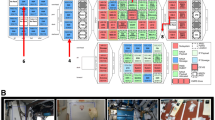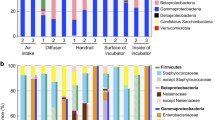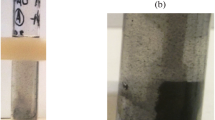Abstract
Samples of microorganisms from the surface of constructions of Mir Space Station (Mir SS) were taken and examined after 13 years of operation. The following microorganisms were isolated and identified: 12 fungal species belonging to the genera Penicillium, Aspergillus, Cladosporium, and Aureobasidium; 3 yeast species belonging to the genera Debaryomyces, Candida, and Rhodotorula; and 4 bacterial species belonging to the genera Bacillus, Myxococcus, and Rhodococcus. The predominant species in all samples was Penicillium chrisogenum. It was shown that the fungi isolated could damage polymers and induce corrosion of aluminum-magnesium alloys. We commenced a study of microbial degraders on constructions of the Russian section of the International Space Station (RS ISS). Twenty-six species of fungi, bacteria, yeasts, and actinomycetes, known as active biodegraders, were identified in three sample sets taken at intervals. We founded a collection of microorganisms surviving throughout space flights. This collection can be used to test spacecraft production materials, in order to determine their resistance to biodegradation.
Similar content being viewed by others
REFERENCES
Novikova, N.D., Kosm. Biol. Aviakosm. Med., 2001, vol. 34, no.4, pp. 32–40.
Shnyreva, A.V., Sizova, T.P., Bragina, M.P., Viktorov, A.N., and D’yakov, Yu.T., Mikol. Fitopatol., 2001, vol. 35, no.3, pp. 37–43.
Klintworth, R., Reher, H.J., Viktorov, A.N., and Bohle, D., Acta Astronaut., 1999, vol. 44, nos.7–12, pp. 569–578.
Metody pochvennoi mikrobiologii i biokhimii (Methods of Soil Microbiology and Biochemistry), Zvyaguntsev, D.G., Ed., Moscow: Mosk. Gos. Univ., 1991.
Bergey’s Manual of Determinative Bacteriology, 9th ed., Holt, J.G., Krieg, N.R., Sneath, P.H.A., Staley, J.T., and Williams, S.T., Eds., 9th edition, Baltimore: Williams and Wilkins, 1993. Translated under the title Opredelitel’ bakterii Berdzhi, Moscow: Mir, 1997.
Bilai, V.I., Gvosdek, R.I., Skripal’, I.G., Kraev, V.G., Ellanskya, M.A., Zirka, G.I., and Mudras, V.A., Microorganizmy—vozbuditeli boleznei rastenii (Microorganisms as Causal Agents of Plant Diseases), Kiev: Naukova Dumka, 1988.
Satton, D., Fotergill, A., and Rinal’di, M., Opredelitel’ patogennykh i uslovno patogennykh gribov (A Laboratory Guide to Pathogenic and Conditionally Pathogenic Fungi), Moscow: Mir, 2001.
Ellis, M.B., Dematiaceous Hyphomycetes, Commonwealth Mycologigical Institute Kew, Kew: Surrey, 1971.
Hoog, G.S. and Guarro, J., Atlas of Clinical Fungi, Baarn: Centraalbureau voor Schimmelcultures, 1995.
Kurtzman, C.P. and Fell, J.W., The Yeasts, a Taxonomic Study, Amsterdam: Elsevier Science, B.V., 1998.
Pitt, J.I., A Laboratory Guide to Common Penicillium Species, North Ryde, N. S.W., Australia: CSIRO, Division of Food Processing, 1991.
Ramirez, C., Manual and Atlas of the Penicillia, Elsiveier Biomed. Press, 1982.
Raper, K.B. and Fennel, D.I., The Genus Aspergillus, Baltimore: Williams and Wilkins, 1965.
The Prokaryotes. The Handbook on Habitats, Isolation, and Identification of Bacteria, vol. 1, 2, Starr, M.P., Stolp, H., et al., Eds., Berlin: Springer, 1981, p. 2284.
Thom, C.A. and Raper, K.B., Manual of the Penicillia, New York: Hefner Publishing Co., 1968.
Domsch, K.H., Gams, W., and Anderson, T.H., Compendium of Soil Fungi, 2nd ed., London: Academic, 1993.
Gu, J.D., Roman, M., Elsseman, T., and Mitchel, R., Int. Biodeterior. Biodegrad., 1988, vol. 41, no.1, pp. 25–33.
Nallii, S., Cooper, D.G., and Nicell, J.A., Biodegradation, 2002, vol. 13, no.5, pp. 343–352.
Kozlovskii, A.G., Zhelifonova, V.P., Antipova, T.V., Adanin, V.M., Novikova, N.D., Deshevaya, E.A., Shlegel’, B., Daze, Kh.M., Gollmik, F., and Grefe, U., Prikl. Biokhim. Mikrobiol., 2004, vol. 40, no.3, pp. 334–349.
Lugauskas, A.Yu., Mikul’skene, A.I., and Shlyauzhene, D.Yu., Katalog mikromitsetov-biodestruktorov poli-mernykh materialov (Catalogue of Micromycetes-Biodestructors of Polymeric Materials), Gorlenko, M.V, Ed., Moscow: Nauka, 1987.
Alekhova, T.A., Aleksandrova, A.A., Novozhilova, T.Yu., Lysak, L.V., Golutvin, I.A., Nasikan, N.S., Zagustina, N.A., Plotnikov, A.D, and Borisov, V.A., Poverkhnost, 2005, no. 1, pp. 54–59.
Feofilova, E.P., Pigmenty mikroorganizmov (Pigments of Microorganisms), Moscow: Nauka, 1974.
Nesterenko, O.A., Kvasnikov, E.L., and Nogina, T.M., Nokardiopodobnye i korinepodobnye bakterii (Nocardiaform and Coryneform Bacteria), Kiev: Naukova Dumka, 1985.
Author information
Authors and Affiliations
Additional information
__________
Translated from Prikladnaya Biokhimiya i Mikrobiologiya, Vol. 41, No. 4, 2005, pp. 435–443.
Original Russian Text Copyright © 2005 by Alekhova, Aleksandrova, Novozhilova, Lysak, Zagustina, Bezborodov.
Rights and permissions
About this article
Cite this article
Alekhova, T.A., Aleksandrova, A.A., Novozhilova, T.Y. et al. Monitoring of Microbial Degraders in Manned Space Stations. Appl Biochem Microbiol 41, 382–389 (2005). https://doi.org/10.1007/s10438-005-0065-x
Received:
Issue Date:
DOI: https://doi.org/10.1007/s10438-005-0065-x




